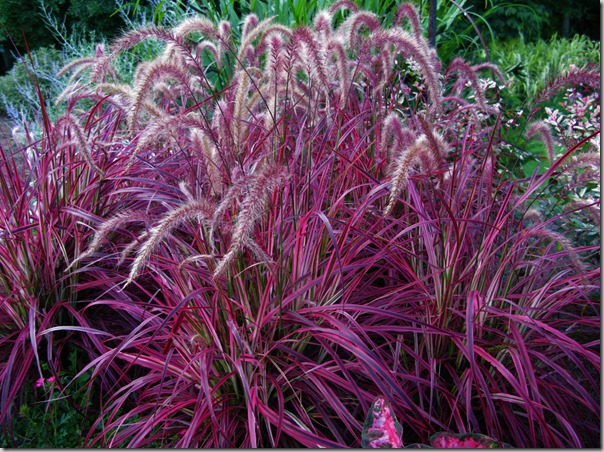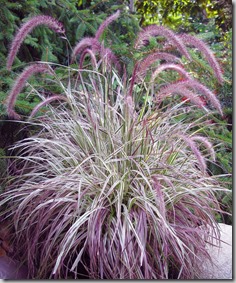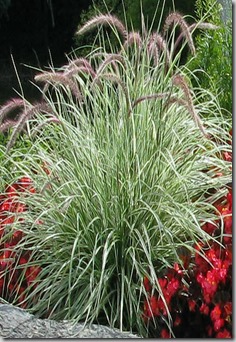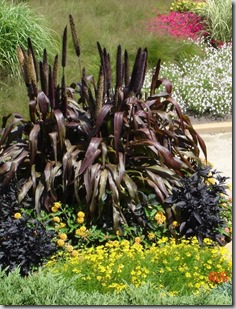While many in the perennial world seem to think that annuals have gone out of style, the “wow” factor they provide is undeniable. Tropical plants and annual flowers are perfect for temporarily filling in the spaces between slow-growing shrubs and trees, which is one of the many reasons books like Stephanie Cohen and Jennifer Benner’s The Nonstop Garden recommend that annuals and tropicals make up about 20% of your garden beds.
New varieties of fountain grass have become the latest trend for those looking for a fast, bodacious blast of seasonal color. You might think of fountain grass as being one of the sturdiest perennials around, even for colder climates. But these new varieties fall under the category of “temperennial” (read it again, I didn’t say temperamental!), which is to say they’re a perennial in temperate zones 9 to 11, but best treated as an annual in cooler climes or areas with a lot of rainfall (i.e., most of the Northwest).
Can it be a little spendy to fill your garden with what are essentially $15 annuals? Sure! Is it worth it? Well, if you spend a lot of time outside, entertain a lot, or are just really geeky about your garden, I’d say yes, within reason. I have one or two fluctuating/ bare areas that I fill in with annuals and biennials of varying price ranges so my garden feels a little different year to year, and that’s been the perfect compromise for me between budget and beauty. And these dramatic new Pennisetums fill the garden beds with motion and much-appreciated verticality.
Fireworks fountain grass

Fireworks fountain grass, Pennisetum ‘Fireworks’, explodes in an array of hot pinks, deep magentas, and burgundy mixed with green. The flower plumes arrive in summer and fall, and have a rich burgundy-purple tone which fades to cream as the flowers age. The entire plant reaches about 3 feet tall and 2 1/2 feet wide, and needs full sun, regular water, and good drainage to perform its best. For continuity throughout the garden, pair Fireworks fountain grass with vivid magenta coral bells such as Heuchera ‘Midnight Bayou’, ‘Midnight Rose’, or ‘Shanghai’ (USDA zones 4-9).
Cherry Sparkler fountain grass
 Foliage that reads as pink is an unusual quality in the garden, which is why Cherry Sparkler fountain grass, Pennisetum ‘Cherry Sparkler’, is such a beaut. The green and white variegated foliage is lightly blushed with burgundy, but from afar the coloration reads as cream and pink. The emerging flower plumes are also blushed with purple, giving this grass airy, multilayered interest.
Foliage that reads as pink is an unusual quality in the garden, which is why Cherry Sparkler fountain grass, Pennisetum ‘Cherry Sparkler’, is such a beaut. The green and white variegated foliage is lightly blushed with burgundy, but from afar the coloration reads as cream and pink. The emerging flower plumes are also blushed with purple, giving this grass airy, multilayered interest.
Cherry Sparkler grows to the same size and has the same care needs as Fireworks fountain grass. Carry the theme throughout the garden with pinky purple Chinese fringe flower varieties such as Loropetalum chinense ‘Razzleberri’ (USDA zones 7-9).
Skyrocket fountain grass
 If you’re not feeling quite adventurous enough for either Fireworks or Cherry Sparkler but would like some verticality and color in your garden beds, Skyrocket fountain grass, Pennisetum ‘Skyrocket’, might just be the grass for you. It’s variegated white and green, with subtle burgundy flower plumes in summer and fall. Because the coloration is a little more restrained, it fits easily into pretty much any design scheme, whether a traditional flower bed or a more sedate planting of shrubs.
If you’re not feeling quite adventurous enough for either Fireworks or Cherry Sparkler but would like some verticality and color in your garden beds, Skyrocket fountain grass, Pennisetum ‘Skyrocket’, might just be the grass for you. It’s variegated white and green, with subtle burgundy flower plumes in summer and fall. Because the coloration is a little more restrained, it fits easily into pretty much any design scheme, whether a traditional flower bed or a more sedate planting of shrubs.
Skyrocket grows to the same size and has the same cultural needs as both Cherry Sparkler and Fireworks. It makes a graceful pairing with Everest EverColor sedge, Carex oshimensis ‘Everest’ (USDA zones 6-8), with its similarly stunning white and green variegation.
Purple Majesty ornamental millet
 The strappy purple-brown leaves of Purple Majesty ornamental millet, Pennisetum glaucum ‘Purple Majesty’, add drama to any planting. The wide leaf blades provide bold textural interest against perennial flowers, more finely textured grasses, or foliage displays of any kind. An added benefit is that their chocolate brown seed heads are attractive to birds in fall. Since Sunset (makers of our beloved Western Garden Book) recommended this plant, I asked them what they loved about it.
The strappy purple-brown leaves of Purple Majesty ornamental millet, Pennisetum glaucum ‘Purple Majesty’, add drama to any planting. The wide leaf blades provide bold textural interest against perennial flowers, more finely textured grasses, or foliage displays of any kind. An added benefit is that their chocolate brown seed heads are attractive to birds in fall. Since Sunset (makers of our beloved Western Garden Book) recommended this plant, I asked them what they loved about it.
“When we grew it here at Sunset, the seed heads were so covered with feeding birds that the plant looked like it was blooming with birds,” said Kathy Brenzel of Sunset Publishing. While Purple Majesty can reach up to 5 feet tall, it has a slender habit and only gets about 1-2 feet wide, so should be planted in groupings in all but the smallest gardens.
4 responses to “Fabulous Fountain Grasses: “Temperennial” New Varieties”
where can i buy this cherry sparkler fountan grass?
Try googling “cherry sparkler fountain grass buy”. I found a number of sources. Jung Seed is one.
I have a strip of dirt in my backyard that’s about 20 ft. long but only about 2 1/2 to 3 ft. wide , Can i plant a skyrocket fountain in that space?
On The Burgundy Bunny Fountain Grass
[…] nnuals and biennials of varying price ranges so my garden feels a little differe […]